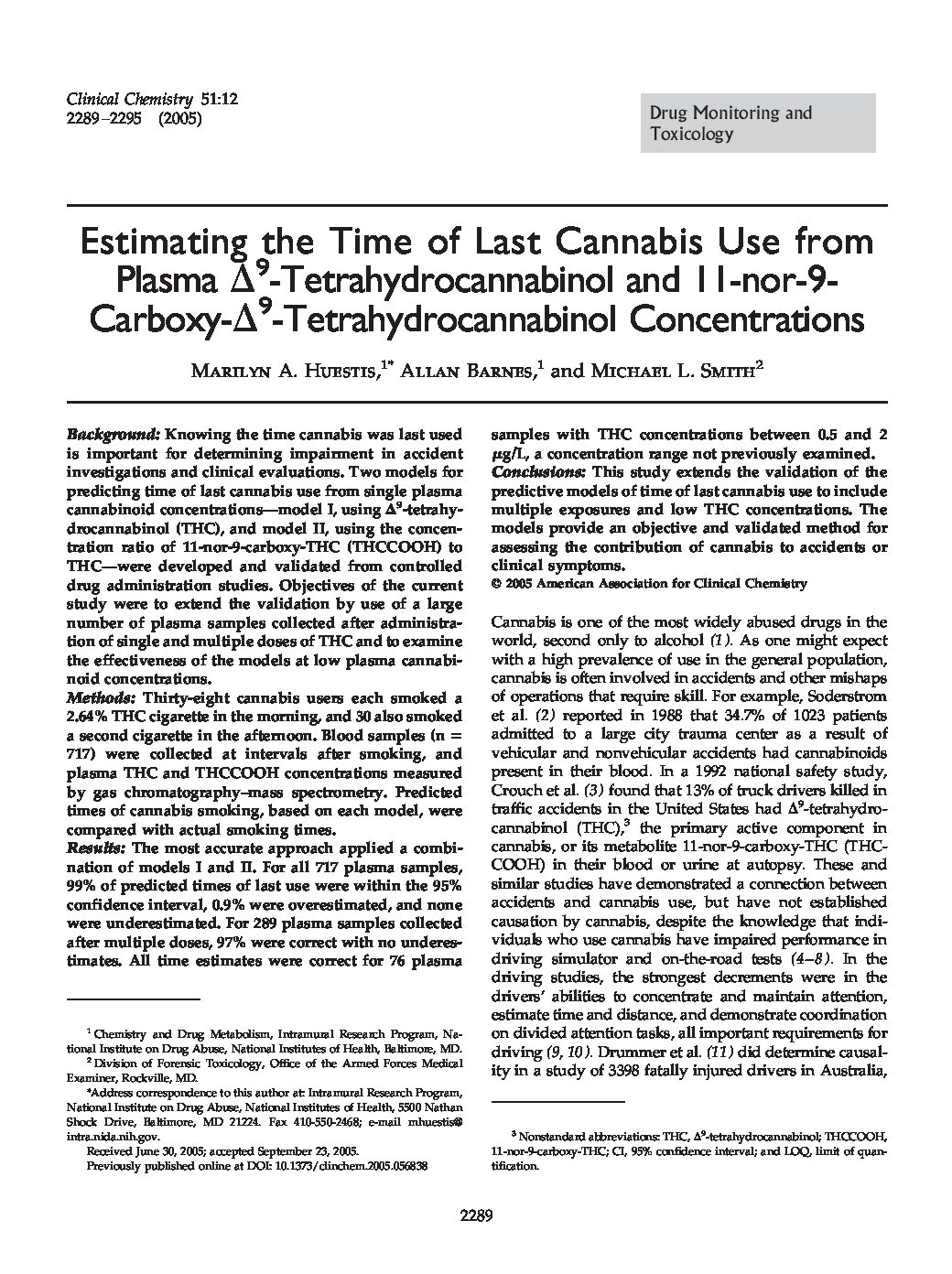
Apr 27, 2022 | Academia, Blog
Estimating the Time of Last Cannabis Use from Plasma 9-Tetrahydrocannabinol and 11-nor-9-Carboxy- 9-Tetrahydrocannabinol Concentrations
Summary of this paper
Our Machine-Learning algorithms scan the text for the most important phrases or passages. These highlights, alongside their respective section titles, are shown below.
Section 1
First samples were collected at 1 min after smoking and at frequent intervals up to 168 h. From these data, the authors developed 2 models to predict time of last cannabis use within 95% confidence intervals (CIs). The first model computed the elapsed time between smoking cannabis and blood collection based on plasma THC concentration alone, whereas the second model used the plasma THCCOOH/THC concentration ratio. They applied the models to results from all published studies at the time that reported THC and/or THCCOOH concentrations measured by either RIA or gas chromatography-mass spectrometry with either internal or external standardiza-tion.Go To Passage
Materials And Methods Participants And Study Design
At 0900 on the day of testing, participants received a single oral dose of placebo (n ϭ 10) or up to 90 mg of rimonabant. Two hours later, they smoked a cannabis cigarette containing 2.64% THC by weight, estimated to contain ϳ20 mg of THC. The number of puffs and time between puffs were standardized.Go To Passage
Hiring a lawyer is an expense nobody wants. Not hiring a lawyer can cost you a lifetime of grief.
The decision is yours. Hire a lawyer that will work for you and not for the system. KomornLaw.com
Analytical Method
Model I determined time estimates from plasma THC concentrations and model II from the plasma THCCOOH/THC concentration ratios. The formulas are reproduced below, with t representing the elapsed time in hours between the beginning of cannabis smoking and blood collection, and CI representing the 95% confidence interval for the estimate of t. The subscripts 1 and 2 refer to models I and II, respectively, and brackets indicate the concentrations of THC or THC-COOH in g/L: 123.420 ͮ These equations were developed from cannabinoid concentrations in plasma samples collected for up to 168 h after controlled smoking of a 1.75% and a 3.55% THC cigarette by each of 6 cannabis users residing continuously in a secure clinical research unit (19 ). Drug administration was not initiated until their urine cannabinoid concentrations were Ͻ20 g/L.Go To Passage
Results
The results for predicted elapsed times between the beginning of cannabis smoking and blood collection obtained with model I, model II, and a combination of the models are summarized in Table 2. The conditions for the single cigarette study were similar to those in the study used to produce the models, except that cigarettes contained 2.64% THC instead of either 1.75% or 3.55% THC, and length of inhalation and the time smoke was held in the lungs were not controlled. For model I, Table 2 reflects that, for 392 of 427 samples collected from 38 individuals after they began smoking the first cigarette, the observed time fell within the predicted range of elapsed time.Go To Passage
Discussion
Other studies also have shown that cannabis users tend to titrate their dose of drug to maintain the level of intoxication they Table 3. Predicted elapsed time between cannabis smoking and blood collection with plasma THC between 0.5 and 2.0 g/L and THCCOOH >2.5 g/L. prefer (20 ).Go To Passage

Apr 22, 2022 | Academia, Blog
Summary of this paper
Our Machine-Learning algorithms scan the text for the most important phrases or passages. These highlights, alongside their respective section titles, are shown below.
Introduction
To our knowledge, there have been no studies of deposition of cannabinoids in human hair following controlled administration of cannabis or THC. Most studies rely on self-reports of cannabis use. In cases where individuals have reasons to hide their drug use, self-report can be unreliable [21].Go To Passage
Subjects
They provided written informed consent to take part in controlled oral and smoked drug administration studies evaluating the pharmacokinetics and pharmacodynamics of cannabis. Subjects completed a questionnaire regarding drug use habits and had hair collected before and after drug administration. The National Institute on Drug Abuse Institutional Review Board approved the randomized, double blind, double dummy, placebo-controlled clinical studies and subjects were compensated for participation. Go To Passage
Clinical Research Protocol
The two highest doses were in the last month of administration. The total THC administered was 116 mg. Hair specimens were collected at the end of the 10-week period 7-10 days after the last dose was administered.Go To Passage
Hair Collection Protocol
For the purposes of this investigation and in accordance with routine hair testing practices, the first 3.9 cm of hair closest to the scalp was analyzed to reveal drug use within the last three months. A total of 53 hair specimens were collected. Hair specimens were randomized and blinded prior to analysis at American Medical Laboratories (currently Quest Diagnostics), Las Vegas, NV. Go To Passage
Gcmsms Analysis For Thc And Thccooh In Hair
Calibration samples contained 5 and 0.5 pg/mg THC and THCCOOH, respectively. Controls in certified negative hair matrix were prepared at 0, 3.0 and 7.0 pg THC/mg hair and 0, 0.3 and 0.7 pg THCCOOH/mg hair. A blind quality control sample at a concentration within the linear range was also included with each analytical batch. Go To Passage
When you need an attorney to represent your Cannabis Business who has the experience and intimate knowledge of the industry – Take a good look at Komorn Law PLLC – a law firm that has been on the front line defending the future of cannabis both medical, recreational and in the justice system providing legal defense services.
Immunoassay For Cannabinoids In Hair
It was adapted and validated for the analysis of cannabinoids in human hair. The LOD of the assay was 2 pg THC equivalents/mg and a cutoff concentration of 5 pg THC equivalents/mg hair was used to screen all specimens. Intra-and interassay precisions at the cutoff concentration were 1.7 % and 9.3 %, respectively. Go To Passage
Statistical Tests
Several procedures for detecting use of cannabis or THC were evaluated. We determined the fraction of specimens that were positive using each of the following criteria: GCMSMS for THC ≥ LOQ, GCMSMS for THCCOOH ≥ LOQ, immunoassay cannabinoids ≥ 5 pg THC equivalents/mg hair, and both immunoassay and THCCOOH ≥ respective cutoff concentrations. Fisher’s exact test, two-tailed, was used to compare the fractions of positive specimens, i.e. detection rates, for daily and non-daily users, AA and C subjects, and to test for independence of detection rates for subjects before and after smoked cannabis [22]. Go To Passage
Results
For those specimens with detectable cannabinoids, the range of concentrations for THC was 3.4 to > 100 pg/mg of hair and for THCCOOH 0.10 (the LOQ) to 7.3 pg/mg hair (Table 1). THC and THCCOOH concentrations were positively correlated (r = 0.38, p < 0.01, Pearson’s product moment correlation, excluding the subject with > 100 pg THC/mg hair). Median THC and THCCOOH concentrations were higher for daily users and AA subjects, but elevations were not statistically significant (Mann-Whitney Rank Sum Test, all p > 0.2, see Figures 1 and 2). Go To Passage
Discussion
For many drugs the parent compound is in much higher concentration in hair than water-soluble metabolites and this is also true for cannabinoids. Concentrations ranged from 3.4 to > 100 pg THC/mg hair compared to 0.10 to 7.3 pg THCCOOH/mg hair. THC concentrations compared well with those reported by other investigators [7,8,10], while THCCOOH concentrations were similar to those reported by Moore et al. Go To Passage
Conclusions
THC and THCCOOH concentrations were positively correlated (r = 0.38, p < 0.01, Pearson’s product moment correlation). Using an immunoassay cutoff concentration of 5 pg THC equivalents/mg hair, 83% of specimens that screened positive were confirmed by GCMSMS at a cutoff concentration of 0.1 pg THCCOOH/mg hair. Concentrations of (a) Δ 9 -tetrahydrocannbinol (THC) and (b) 11-nor-Δ 9tetrahydrocannbinol-9-carboxylic acid (THCCOOH) in hair of cannabis users. Go To Passage
Source

Apr 22, 2022 | Academia, Blog
Academia – Summary of this paper
Excretion of Delta 9-tetrahydrocannabinol in sweat. Our Machine-Learning algorithms scan the text for the most important phrases or passages. These highlights, alongside their respective section titles, are shown below.
Introduction
Saito et al. reported a validated gas chromatography-mass spectrometry (GC/MS) method with a LOQ of 0.4 ng THC/patch and found concentrations of 0.9 to 3.1 ng THC/patch in several 24-hour sweat patches from one cannabis user [20]. The expected disposition of THC in sweat from chronic cannabis users has not been reported.
Subjects And Study Design
Exact times of dosing were recorded, but target times each day were 0800, 1300 and 1730 h. After five consecutive dosing days, there was a 10-day washout period prior to the next dosing condition. Subjects had five dosing conditions involving placebo, low-dose liquid hemp oil (9 μg/g or a daily dose of 0.39 mg THC), low-dose hemp oil in capsules (92 μg/g or a daily dose of 0.47 mg THC), high-dose hemp oil (347 μg/g or a daily dose of 14.8 mg THC) and dronabinol (2.5 mg/capsule or a daily dose of 7.5 mg THC). Sweat patches were stored at −20°C until THC analysis.
Gc/Ms Analysis
Percent recovery from patches was 44-46%, LOQ was 0.4 ng THC/patch and coefficients of variation were < 10%. All weekly patches were tested. Some daily patches were not tested if no THC was found in the corresponding weekly patch.
When you are ready to start a business or protect your business. Michigan’s top referred Cannabis Business Services and Licensing law firm. Komorn Law PLLC – 800-656-3557.
Results
Prior to receiving their first THC dose, frequent cannabis users (Group 2) produced their first negative urine specimen, i.e. less than 10 μg/L, within one to three weeks. During this washout phase, the first weekly sweat patch from two of seven subjects had THC above the assay LOQ. One weekly patch contained 0.93 ng THC/patch, with none of the seven daily sweat patches worn this week positive for THC.
Discussion
The manufacturer recommends that the patches be worn for one week. In the present study, sweat patches worn by daily cannabis users the first week of monitored abstinence had THC concentrations averaging 3.85 ng/patch. There are no other published studies reporting sweat patch THC concentrations after cessation of use for comparison.
Conclusions
Results of our clinical study indicate that daily cannabis users will excrete THC into sweat in concentrations above the SAMHSA cutoff of 1 ng/patch. During abstinence, negative patches are expected after one week, but some may have a longer washout period of four weeks or more. The sensitivity of sweat patches to detect new drug use following cannabis smoking is not known and requires an independent controlled smoked cannabis administration study.
Author
Marilyn Huestis
University of Maryland School of Medicine – Faculty Member
Professor Dr. Dr. (h.c.) Marilyn A. Huestis recently retired as a tenured senior investigator and Chief, Chemistry and Drug Metabolism Section, National Institute on Drug Abuse, National Institutes of Health, after 23 years of conducting controlled drug administration studies. She is an Adjunct Professor, University of Maryland Baltimore School of Medicine.
Source

Apr 12, 2022 | Academia, Blog
Delta(9)-tetrahydrocannabinol, 11-hydroxy-delta(9)-tetrahydrocannabinol and 11-nor-9-carboxy-delta(9)-tetrahydrocannabinol in human plasma after controlled oral administration of cannabinoids
Summary of this paper
Our Machine-Learning algorithms scan the text for the most important phrases or passages. These highlights, alongside their respective section titles, are shown below.
Section 1
Although there are several pharmacokinetic studies of THC and its metabolites in plasma or urine after smoked cannabis, [25][26][27][28][29][30] few studies have investigated their disposition in plasma after oral administration. [13][14][15] The objectives of this study were to determine plasma profiles of THC, 11-hydroxy-D 9 -tetrahydrocannabinol (11-OH-THC), and THCCOOH after controlled ingestion of natural cannabinoids in hemp oil and synthetic THC (dronabinol) and to relate these concentrations to ongoing physiological and subjective effects.Go To Passage
Participants
Six healthy participants with a history of cannabis use resided in the secure clinical research unit of the National Institute on Drug Abuse (NIDA) Intramural Research Program, National Institutes of Health while participating in a protocol designed to characterize the pharmacokinetics and pharmacodynamics of oral THC. The NIDA Institutional Review Board approved the study. All participants provided written informed consent, were under continuous medical supervision, and were financially compensated for their time and inconvenience.Go To Passage
Drug Administration
A total daily dose of 14.8 mg THC was achieved with the high-dose hemp oil (concentration 347 mg THC/g hemp oil). Dronabinol (synthetic THC in sesame oil), 2.5 mg THC per capsule, was administered as a positive control with a daily total dose of 7.5 mg. For safety reasons, only 2 doses (5.0 mg THC) were administered on the first dosing day of the session. Doses administered reflected concentrations of THC in commercially available hemp oil at the time of study design.Go To Passage
Clinical Specimen Analysis
Blood was collected on ice, centrifuged, and plasma removed within 2 hour; specimens were stored at À 201C until analysis. A previously published procedure for the simultaneous extraction and quantification of THC, 11-OH-THC, and THCCOOH was employed. Escherichia coli b-glucuronidase hydrolysis cleaved glucuronic acid moieties to capture total cannabinoid concentrations.Go To Passage
When you need an attorney to represent your Cannabis Business who has the experience and intimate knowledge of the industry – Take a good look at Komorn Law PLLC – a law firm that has been on the front line defending the future of cannabis both medical, recreational and in the justice system providing legal defense services.
Statistical Analysis
Plasma THC, 11-OH-THC, and THCCOOH concentrations were compared between the 7.5 and 14.8 mg THC/d dosing sessions with analysis of variance (ANOVA) and Wilcoxon Signed Ranks Test for Areas Under the Curve. Correlations of body mass index (BMI) and C max and for the number of specimens positive for THC and 11-OH-THC were analyzed by Spearman’s rank correlation coefficient.Go To Passage
Results
The number of specimens positive for THCCOOH during and after the 0.39 and 0.47 mg THC/d regimens varied widely, ranging from 0 to 23, out of a possible 28 per participant. Participant N had 9 of 15 specimens positive for THC and 6 of 18 positive for 11-OH-THC during dosing with the high potency oil and capsules (Fig. 1), considerably more than any other subject. Participants A, H, P, L, and O had 11,8,8,, and 0 of 36 positive specimens, respectively.Go To Passage
Discussion
In the present study, concentrations of THC and 11-OH-THC were similar during the 7.5 mg THC/d dronabinol and 14.8 mg THC/d hemp oil doses, never exceeding 6.1 ng/mL. No specimens had measurable THC or 11-OH-THC during or after the 0.39 or 0.47 mg THC/ d dosing sessions. The lower dose regimens are reflective of THC concentrations in hemp oil currently produced by US manufacturers, indicating that consumption of these hemp oils according to manufacturer’s instructions should not lead to positive THC or 11-OH-THC plasma tests.Go To Passage
Conclusions
Nearly all specimens had measurable THCCOOH. There was a significant correlation between BMI and the number of specimens positive for THC and 11-OH-THC and between BMI and C max for both analytes, possibly indicating greater deposition in adipose tissue and release to plasma of THC and metabolites in obese individuals. These controlled drug administration data should assist in the interpretation of plasma cannabinoid results and provide clinicians with valuable information for future pharmacological studies.Go To Passage

Feb 10, 2021 | Blog
Summary of this paper
Our Machine-Learning algorithms scan the text for the most important phrases or passages. These highlights, alongside their respective section titles, are shown below.
Introduction
Saito et al. reported a validated gas chromatography-mass spectrometry (GC/MS) method with a LOQ of 0.4 ng THC/patch and found concentrations of 0.9 to 3.1 ng THC/patch in several 24-hour sweat patches from one cannabis user [20]. The expected disposition of THC in sweat from chronic cannabis users has not been reported.Go To Passage
Subjects And Study Design
Exact times of dosing were recorded, but target times each day were 0800, 1300 and 1730 h. After five consecutive dosing days, there was a 10-day washout period prior to the next dosing condition. Subjects had five dosing conditions involving placebo, low-dose liquid hemp oil (9 μg/g or a daily dose of 0.39 mg THC), low-dose hemp oil in capsules (92 μg/g or a daily dose of 0.47 mg THC), high-dose hemp oil (347 μg/g or a daily dose of 14.8 mg THC) and dronabinol (2.5 mg/capsule or a daily dose of 7.5 mg THC). Sweat patches were stored at −20°C until THC analysis.Go To Passage
Gc/Ms Analysis
Percent recovery from patches was 44-46%, LOQ was 0.4 ng THC/patch and coefficients of variation were < 10%. All weekly patches were tested. Some daily patches were not tested if no THC was found in the corresponding weekly patch.Go To Passage
Results
During this washout phase, the first weekly sweat patch from two of seven subjects had THC above the assay LOQ. One weekly patch contained 0.93 ng THC/patch, with none of the seven daily sweat patches worn this week positive for THC. The other weekly sweat patch contained 0.82 ng THC/patch, with only the first daily patch positive for THC at 0.44 ng of THC/patch.Go To Passage
Discussion
The manufacturer recommends that the patches be worn for one week. In the present study, sweat patches worn by daily cannabis users the first week of monitored abstinence had THC concentrations averaging 3.85 ng/patch. There are no other published studies reporting sweat patch THC concentrations after cessation of use for comparison.Go To Passage
Conclusions
Results of our clinical study indicate that daily cannabis users will excrete THC into sweat in concentrations above the SAMHSA cutoff of 1 ng/patch. During abstinence, negative patches are expected after one week, but some may have a longer washout period of four weeks or more. The sensitivity of sweat patches to detect new drug use following cannabis smoking is not known and requires an independent controlled smoked cannabis administration study.
Read the Full PDF Here
Marilyn A. Huestis1,*
, Karl B. Scheidweiler1, Takeshi Saito1,2, Neil Fortner3, Tsadik
Abraham1, Richard A. Gustafson4, and Michael L. Smith5
1 Chemistry and Drug Metabolism, Intramural Research Program, National Institute on Drug Abuse,
National Institutes of Health, Baltimore, MD, USA
2 Tokai University School of Medicine, Kanagawa, Japan
3 ChoicePoint, Inc., Alpharetta, GA
4 Lieutenant Commander, U S Navy, Navy Drug Screening Laboratory, Jacksonville, FL USA
5 Division of Forensic Toxicology, Office of the Armed Forces Medical Examiner, Armed Forces Institute of
Pathology, Rockville, MD, USA
Source: Academia
Komorn Law Social Media
Recent Posts
Tag Cloud
2021
BMMR
cannabis
CBD
corruption. prosecutors
dispensary
Driving
DUI
forfeiture
gun rights
hemp
komornlaw
lara
law enforcement abuse
laws
Legalization
marijuana
Medical Marijuana
Michigan
michigan laws
michigan news
MMFLA
MRA
news
police
politics
science
usa news
us supreme court
Your Rights
DISCLAIMER
This post may contain re-posted content, opinions, comments, ads, third party posts, outdated information, posts from disgruntled persons, posts from those with agendas and general internet BS. Therefore…Before you believe anything on the internet regarding anything – do your research on Official Government and State Sites, Call the Michigan State Police, Check the State Attorney General Website and Consult an Attorney – Use Your Brain.

















